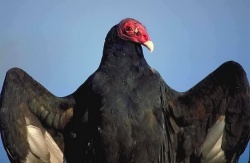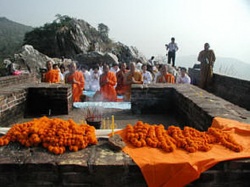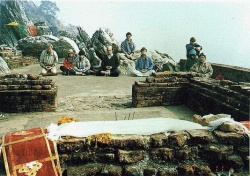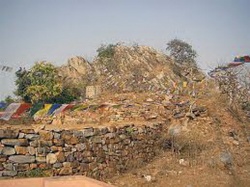Difference between revisions of "Vulture Peak"
| Line 1: | Line 1: | ||
| + | [[File:Turkvul2.jpg|thumb|250px|]] | ||
<poem> | <poem> | ||
| − | "Thus it has been said when [[Shakyamuni Buddha]] was in Grdhrakuta mountain, he twirled a [[flower]] in his finger and held it before his congregation. Everyone was [[silent]]. Only [[Maha]] | + | "Thus it has been said when [[Shakyamuni Buddha]] was in [[Grdhrakuta mountain]], he twirled a [[flower]] in his finger and held it before his congregation. Everyone was [[silent]]. Only [[Maha Kashapa]] wholeheartedly smiled. [[Buddha]] said, 'I have the [[eye]] of the [[true teaching]], the [[heart]] of [[Nirvana]], the [[formless]] [[form]], the mysterious gate of [[Dharma]]. [[Beyond]] the words and [[beyond]] all teachings to be transmitted, I now pass this on to [[Maha Kashapa]].'" |
| − | + | [[File:Vulture-peak_jpg.jpg|thumb|250px|]] | |
| − | + | One of the most important of all associations with a "place" in the [[life]] and teachings of the [[Buddha]], other than the [[Bodhi Tree]] and [[Deer Park]], is with [[Vulture Peak]], a small mountain just outside the city of the {{Wiki|ancient}} city of [[Rajgir]], [[India]]. Here, sixteen years after his [[Enlightenment]], he set forth the second turning of the [[wheel]] of [[Dharma]] to an assembly of 5,000 [[monks]], [[nuns]] and laity, as well as innumerable [[bodhisattvas]]. This collection of teachings, which extended over twelve years, includes the [[Saddharmapundarika Sutra]] and the [[Surangama Samadhi Sutra]], as well as many [[Prajna-paramita Sutras]], which, as the [[Buddha]] himself told [[Ananda]], contain the very [[essence]] of all his teachings. [[Mahakashyapa]] recorded these latter teachings and [[Shakyamuni]] placed them in the custody of the [[nagas]] until such [[time]] as men were ready to receive them. The [[Prajna Paramita]] [[Sutras]] appeared between 200 B.C.E and 400 C.E., and considered the beginning of the [[Mahayana literature]]. There are 600 volumes in the [[Prajna Paramita]] and the [[Heart Sutra]] is the condensation, or the "[[heart]]," of all the [[Prajna Paramita]] {{Wiki|literature}}. The [[Diamond Sutra]], the [[Sixth Patriarch]] of {{Wiki|Chinese}} [[Ch'an]] ([[Zen]]) [[Hui Neng's]] favorite [[sutra]] and the one attributed to his [[Awakening]], is part of the [[Prajna Paramita]] {{Wiki|literature}} as well. | |
| − | + | [[File:Peak3.jpg|thumb|250px|]] | |
| − | |||
| − | One of the most important of all associations with a "place" in the [[life]] and teachings of the [[Buddha]], other than the [[Bodhi Tree]] and [[Deer Park]], is with [[Vulture Peak]], a small mountain just outside the city of the {{Wiki|ancient}} city of [[Rajgir]], [[India]]. Here, sixteen years after his [[Enlightenment]], he set forth the second turning of the [[wheel]] of [[Dharma]] to an assembly of 5,000 [[monks]], [[nuns]] and laity, as well as innumerable [[bodhisattvas]]. This collection of teachings, which extended over twelve years, includes the [[Saddharmapundarika Sutra]] and the | ||
| − | |||
The [[Buddha's]] [[respect]] for [[Mahakashyapa]] was such that when they first met, the two exchanged cloaks. Legend has it he now resides within the Gurupada Mountain near [[Bodhgaya]]. Here he awaits [[Maitreya]], upon whom he will place the cloak of [[Shakyamuni]]. | The [[Buddha's]] [[respect]] for [[Mahakashyapa]] was such that when they first met, the two exchanged cloaks. Legend has it he now resides within the Gurupada Mountain near [[Bodhgaya]]. Here he awaits [[Maitreya]], upon whom he will place the cloak of [[Shakyamuni]]. | ||
| + | [[File:Im4s.jpg|thumb|250px|]] | ||
| + | When the {{Wiki|Chinese}} [[pilgrims]] visited [[Vulture's Peak]] they found the [[summit]] green and bare. [[Fa Hien]] mentions a {{Wiki|cave}} and [[Hsuan Chwang]] a hall slightly below it, where the [[Buddha]] is said to have sat and {{Wiki|preached}}. Here also he once reached through the mountain with his hand to [[calm]] [[Ananda]], whose [[meditation]] was {{Wiki|being}} disturbed by [[Mara]], in [[Buddhism]], the [[lord]] of misfortune, who appeared in the [[form]] of a [[Vulture]] of which, because of the many inhabitants thereof, the peak is named. Before the {{Wiki|cave}} were the walking and sitting places of the previous [[buddhas]], and a [[stupa]] where the [[Saddharmapundarika Sutra]] was taught. | ||
| − | + | [[King]] [[Bimbisara]] built a causeway leading up to the hill. At the foot of the hill was Amaravana, the mango grove [[offered]] to the [[Buddha]] by the {{Wiki|physician}} [[Jivaka]]. The {{Wiki|remains}} of what was once a [[monastery]] may still be seen here. According to [[Hsuan Chwang]], at one [[time]] on [[Vulture's Peak]] there was a [[monastery]] occupied by many [[meditators]] and several [[Arhants]]. | |
| − | + | [http://sped2work.tripod.com/vulturespeak.html sped2work.tripod.com] | |
| − | [[King]] [[Bimbisara]] built a causeway leading up to the hill. At the foot of the hill was Amaravana, the mango grove [[offered]] to the [[Buddha]] by the {{Wiki|physician}} [[Jivaka]]. The {{Wiki|remains}} of what was once a [[monastery]] may still be seen here. According to Hsuan Chwang, at one [[time]] on [[Vulture's Peak]] there was a [[monastery]] occupied by many [[meditators]] and several Arhants. | + | ------------------------------------------------------------------------------------------- |
| − | |||
| − | + | The Gijjhakuta, the [[Vulture Peak]], was the [[Buddha’s]] favorite [[retreat]] in [[Rajagaha]] and the scene for many of his discourses. According to the commentaries this place got its [[name]] because vultures used to perch on some of the peak’s rocks. | |
| − | The several rock shelters around the Gijjhakuta, its fine [[view]] across the valley, and its [[peaceful]] environment made it the perfect place for [[meditation]]. Climbing the steps that lead to the top, the [[pilgrim]] passes a large {{Wiki|cave}}. This is the Sukarakhata (the Boar’s Grotto) where the [[Buddha]] delivered two discourses, the {{Wiki|Discourse}} to Long Nails and the | + | The several rock shelters around the Gijjhakuta, its fine [[view]] across the valley, and its [[peaceful]] environment made it the perfect place for [[meditation]]. Climbing the steps that lead to the top, the [[pilgrim]] passes a large {{Wiki|cave}}. This is the Sukarakhata (the Boar’s Grotto) where the [[Buddha]] delivered two discourses, the {{Wiki|Discourse}} to Long Nails and the [[Sukarakhata Sutta]]. |
It was here too that [[Sariputta]] attained [[enlightenment]]. The Sukarakhata seems to have been formed by excavating the [[earth]] from under the huge rock that [[forms]] the grotto's roof, an [[impression]] confirmed by legend. According to the [[Pali commentaries]] during the [[time]] of [[Kassapa Buddha]] a {{Wiki|boar}} rooting around under the rock made a small cavity which was later enlarged when monsoon rains washed more [[earth]] away. Later, an [[ascetic]] discovered the {{Wiki|cave}} and, deciding it would be a good place to [[live]] in, built a wall around it, furnished it with a couch, and ‘made it as clean as a golden [[bowl]] polished with sand.’ | It was here too that [[Sariputta]] attained [[enlightenment]]. The Sukarakhata seems to have been formed by excavating the [[earth]] from under the huge rock that [[forms]] the grotto's roof, an [[impression]] confirmed by legend. According to the [[Pali commentaries]] during the [[time]] of [[Kassapa Buddha]] a {{Wiki|boar}} rooting around under the rock made a small cavity which was later enlarged when monsoon rains washed more [[earth]] away. Later, an [[ascetic]] discovered the {{Wiki|cave}} and, deciding it would be a good place to [[live]] in, built a wall around it, furnished it with a couch, and ‘made it as clean as a golden [[bowl]] polished with sand.’ | ||
| − | Climbing further, the [[pilgrim]] can see the ruins of [[stupas]] and the foundations of a small [[temple]] built on the [[summit]] in {{Wiki|ancient}} times. When the simple and devoted {{Wiki|Chinese}} [[pilgrim]] [[Fa Hien]] came here, he was deeply moved by the {{Wiki|atmosphere}} on the Gijjhakuta. ‘In the new city, [[Fa Hien]] bought [[incense]], oil and lamps and hired two [[monks]], long residents in the place, to carry them to the peak. When he himself arrived, he made his [[offerings]] with [[flowers]] and [[incense]] and lit the lamps when the darkness began to come on. He felt {{Wiki|melancholy}} but restrained his {{Wiki|tears}}, and said, ‘Here the [[Buddha]] delivered the [[Surangama Sutra]]. I, [[Fa Hien]], was born when I could not meet the [[Buddha]] and now I only see the footprints which he has left and the place where he lived and [[nothing]] more.’ With this, in front of the rock cavern, he chanted the [[Surangama Sutra]], remaining there overnight and then returned towards the new city.’ In Dharmasvamin’s [[time]] (13th century), the Gijjhakuta was ‘the [[abode]] for numerous carnivorous [[animals]] such as {{Wiki|tiger}}, black bear and brown bear,’ and in [[order]] to frighten away the [[animals]], [[pilgrims]] visiting the Gijjhakuta would beat drums, blow conches and carry tubes of green {{Wiki|bamboo}} that would emit sparks. A [[Buddha]] statue, dating from the 6th century CE, found on the Gijjhakuta, is now housed in the {{Wiki|Archaeological}} Museum at [[Nalanda]]. The Gijjhakuta is located about 5 kilometers south-east of the town of [[Rajgir]] and is a popular destination for both local tourists and [[Buddhist]] [[pilgrims]] [[form]] overseas. Because the | + | Climbing further, the [[pilgrim]] can see the ruins of [[stupas]] and the foundations of a small [[temple]] built on the [[summit]] in {{Wiki|ancient}} times. When the simple and devoted {{Wiki|Chinese}} [[pilgrim]] [[Fa Hien]] came here, he was deeply moved by the {{Wiki|atmosphere}} on the Gijjhakuta. ‘In the new city, [[Fa Hien]] bought [[incense]], oil and lamps and hired two [[monks]], long residents in the place, to carry them to the peak. When he himself arrived, he made his [[offerings]] with [[flowers]] and [[incense]] and lit the lamps when the darkness began to come on. He felt {{Wiki|melancholy}} but restrained his {{Wiki|tears}}, and said, ‘Here the [[Buddha]] delivered the [[Surangama Sutra]]. I, [[Fa Hien]], was born when I could not meet the [[Buddha]] and now I only see the footprints which he has left and the place where he lived and [[nothing]] more.’ With this, in front of the rock cavern, he chanted the [[Surangama Sutra]], remaining there overnight and then returned towards the new city.’ In Dharmasvamin’s [[time]] (13th century), the Gijjhakuta was ‘the [[abode]] for numerous carnivorous [[animals]] such as {{Wiki|tiger}}, black bear and brown bear,’ and in [[order]] to frighten away the [[animals]], [[pilgrims]] visiting the Gijjhakuta would beat drums, blow conches and carry tubes of green {{Wiki|bamboo}} that would emit sparks. A [[Buddha]] statue, dating from the 6th century CE, found on the Gijjhakuta, is now housed in the {{Wiki|Archaeological}} Museum at [[Nalanda]]. The Gijjhakuta is located about 5 kilometers south-east of the town of [[Rajgir]] and is a popular destination for both local tourists and [[Buddhist]] [[pilgrims]] [[form]] overseas. Because the [[Sadharmapundrika Sutra]] ([[Lotus Sutra]]) was taught on the Gijjhakuta, the place is particularly popular with [[Japanese]] and [[Korean]] [[pilgrims]]. |
| − | [[Vulture Peak]] may be the second "holiest" place of [[Buddhism]], after the [[Maha | + | [[Vulture Peak]] may be the second "holiest" place of [[Buddhism]], after the [[Maha Bodhi Temple]] because this is the place where the [[Buddha]] spent so much [[time]] on [[retreat]], [[meditating]], and [[teaching]] so many discourses. Many [[Buddhists]] prefer to take the climb up on foot to take the same steps as the [[Buddha]] and his closest [[disciples]]. |
It is also very close to the location of the [[First Buddhist council]] at [[Rajagaha]]. The [[Triple Gem]] is fully represented at [[Vulture Peak]] by the fact that [[Buddha]] spent so much [[time]] there, also [[teaching]] [[Dhamma]] and the other [[Sangha]] members going there for instruction, to teach, to [[meditate]], and to compile all of the teachings at the [[First Buddhist council]] at The Sattapanni {{Wiki|Cave}}, which is about 5 km from [[Vulture Peak]]. | It is also very close to the location of the [[First Buddhist council]] at [[Rajagaha]]. The [[Triple Gem]] is fully represented at [[Vulture Peak]] by the fact that [[Buddha]] spent so much [[time]] there, also [[teaching]] [[Dhamma]] and the other [[Sangha]] members going there for instruction, to teach, to [[meditate]], and to compile all of the teachings at the [[First Buddhist council]] at The Sattapanni {{Wiki|Cave}}, which is about 5 km from [[Vulture Peak]]. | ||
Revision as of 15:08, 20 September 2013
"Thus it has been said when Shakyamuni Buddha was in Grdhrakuta mountain, he twirled a flower in his finger and held it before his congregation. Everyone was silent. Only Maha Kashapa wholeheartedly smiled. Buddha said, 'I have the eye of the true teaching, the heart of Nirvana, the formless form, the mysterious gate of Dharma. Beyond the words and beyond all teachings to be transmitted, I now pass this on to Maha Kashapa.'"
One of the most important of all associations with a "place" in the life and teachings of the Buddha, other than the Bodhi Tree and Deer Park, is with Vulture Peak, a small mountain just outside the city of the ancient city of Rajgir, India. Here, sixteen years after his Enlightenment, he set forth the second turning of the wheel of Dharma to an assembly of 5,000 monks, nuns and laity, as well as innumerable bodhisattvas. This collection of teachings, which extended over twelve years, includes the Saddharmapundarika Sutra and the Surangama Samadhi Sutra, as well as many Prajna-paramita Sutras, which, as the Buddha himself told Ananda, contain the very essence of all his teachings. Mahakashyapa recorded these latter teachings and Shakyamuni placed them in the custody of the nagas until such time as men were ready to receive them. The Prajna Paramita Sutras appeared between 200 B.C.E and 400 C.E., and considered the beginning of the Mahayana literature. There are 600 volumes in the Prajna Paramita and the Heart Sutra is the condensation, or the "heart," of all the Prajna Paramita literature. The Diamond Sutra, the Sixth Patriarch of Chinese Ch'an (Zen) Hui Neng's favorite sutra and the one attributed to his Awakening, is part of the Prajna Paramita literature as well.
The Buddha's respect for Mahakashyapa was such that when they first met, the two exchanged cloaks. Legend has it he now resides within the Gurupada Mountain near Bodhgaya. Here he awaits Maitreya, upon whom he will place the cloak of Shakyamuni.
When the Chinese pilgrims visited Vulture's Peak they found the summit green and bare. Fa Hien mentions a cave and Hsuan Chwang a hall slightly below it, where the Buddha is said to have sat and preached. Here also he once reached through the mountain with his hand to calm Ananda, whose meditation was being disturbed by Mara, in Buddhism, the lord of misfortune, who appeared in the form of a Vulture of which, because of the many inhabitants thereof, the peak is named. Before the cave were the walking and sitting places of the previous buddhas, and a stupa where the Saddharmapundarika Sutra was taught.
King Bimbisara built a causeway leading up to the hill. At the foot of the hill was Amaravana, the mango grove offered to the Buddha by the physician Jivaka. The remains of what was once a monastery may still be seen here. According to Hsuan Chwang, at one time on Vulture's Peak there was a monastery occupied by many meditators and several Arhants.
sped2work.tripod.com
The Gijjhakuta, the Vulture Peak, was the Buddha’s favorite retreat in Rajagaha and the scene for many of his discourses. According to the commentaries this place got its name because vultures used to perch on some of the peak’s rocks.
The several rock shelters around the Gijjhakuta, its fine view across the valley, and its peaceful environment made it the perfect place for meditation. Climbing the steps that lead to the top, the pilgrim passes a large cave. This is the Sukarakhata (the Boar’s Grotto) where the Buddha delivered two discourses, the Discourse to Long Nails and the Sukarakhata Sutta.
It was here too that Sariputta attained enlightenment. The Sukarakhata seems to have been formed by excavating the earth from under the huge rock that forms the grotto's roof, an impression confirmed by legend. According to the Pali commentaries during the time of Kassapa Buddha a boar rooting around under the rock made a small cavity which was later enlarged when monsoon rains washed more earth away. Later, an ascetic discovered the cave and, deciding it would be a good place to live in, built a wall around it, furnished it with a couch, and ‘made it as clean as a golden bowl polished with sand.’
Climbing further, the pilgrim can see the ruins of stupas and the foundations of a small temple built on the summit in ancient times. When the simple and devoted Chinese pilgrim Fa Hien came here, he was deeply moved by the atmosphere on the Gijjhakuta. ‘In the new city, Fa Hien bought incense, oil and lamps and hired two monks, long residents in the place, to carry them to the peak. When he himself arrived, he made his offerings with flowers and incense and lit the lamps when the darkness began to come on. He felt melancholy but restrained his tears, and said, ‘Here the Buddha delivered the Surangama Sutra. I, Fa Hien, was born when I could not meet the Buddha and now I only see the footprints which he has left and the place where he lived and nothing more.’ With this, in front of the rock cavern, he chanted the Surangama Sutra, remaining there overnight and then returned towards the new city.’ In Dharmasvamin’s time (13th century), the Gijjhakuta was ‘the abode for numerous carnivorous animals such as tiger, black bear and brown bear,’ and in order to frighten away the animals, pilgrims visiting the Gijjhakuta would beat drums, blow conches and carry tubes of green bamboo that would emit sparks. A Buddha statue, dating from the 6th century CE, found on the Gijjhakuta, is now housed in the Archaeological Museum at Nalanda. The Gijjhakuta is located about 5 kilometers south-east of the town of Rajgir and is a popular destination for both local tourists and Buddhist pilgrims form overseas. Because the Sadharmapundrika Sutra (Lotus Sutra) was taught on the Gijjhakuta, the place is particularly popular with Japanese and Korean pilgrims.
Vulture Peak may be the second "holiest" place of Buddhism, after the Maha Bodhi Temple because this is the place where the Buddha spent so much time on retreat, meditating, and teaching so many discourses. Many Buddhists prefer to take the climb up on foot to take the same steps as the Buddha and his closest disciples.
It is also very close to the location of the First Buddhist council at Rajagaha. The Triple Gem is fully represented at Vulture Peak by the fact that Buddha spent so much time there, also teaching Dhamma and the other Sangha members going there for instruction, to teach, to meditate, and to compile all of the teachings at the First Buddhist council at The Sattapanni Cave, which is about 5 km from Vulture Peak.



